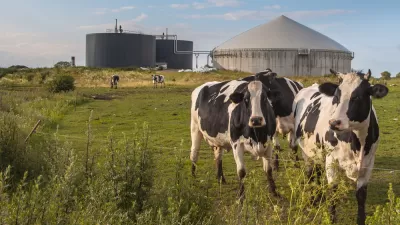No, the title does not refer to Congress, it is meant to be taken literally: It is about the District of Columbia's sewage treatment plant that produces renewable energy by treating its biosolids with a new hydrolysis technology imported from Norway.
The District of Columbia Water and Sewer Authority (D.C. Water), "which also treats sewage from much of the Maryland and Northern Virginia suburbs, recently became the first utility in North America to use a Norwegian thermal hydrolysis system to convert the sludge left over from treated sewage into electricity," writes Katherine Shaver for The Washington Post.
In a Washington Post article last year on the process, Ashley Halsey III wrote that "D.C. Water is the (local) electricity company’s No. 1 customer. By converting poop to power, the water company will cut its Pepco bill by about one third and reduce by half the cost of trucking treated waste elsewhere." The electricity generation from the biomethane produced through anaerobic digesters amounts to 13 megawatts of power.
Anaerobic digestion is not what's new here—it's the "'pressure cooker' technology that can fit such a system in the relatively tight confines of an urban treatment plant," writes Shaver. D.C. Water officials say it’s the largest of its kind in the world. Click here to view the graphic.
“It’s a huge deal on so many fronts,” D.C. Water General Manager George S. Hawkins said after Wednesday’s [Oct. 7] official unveiling of the system. “It’s a public utility leading the world in innovation and technology. We have private and public water companies coming from all over the world to see this.”
From the 2014 article:
“It could be a game changer for energy,” said George Hawkins, an environmentalist who became general manager of D.C. Water. “If we could turn every enriched-water facility in the United States into a power plant, it would become one of the largest sectors of clean energy that, at the moment, is relatively untapped.”
In addition to producing biomethane for electricity generation, the plant produces a "Class A compost-like substance (that) could show up in the next year or so on the shelves of Home Depot as a soil nutrient for home gardens, officials said," adds Shaver.
When you consider the "toilet-to-tap" wastewater recycling process out west, one is left with the recognition that sewage treatment centers may be one of America's last unexploited resources, although this exploitation is environmentally sustainable. Not tapping it would be a shame.
Correspondent's note: See the Department of Energy's Alternative Fuels Data Center to distinguish renewable natural gas from biogas.
Hat tip: Kenyon Karl, Sierra Club
FULL STORY: D.C. Water begins harnessing electricity from every flush

Alabama: Trump Terminates Settlements for Black Communities Harmed By Raw Sewage
Trump deemed the landmark civil rights agreement “illegal DEI and environmental justice policy.”

Study: Maui’s Plan to Convert Vacation Rentals to Long-Term Housing Could Cause Nearly $1 Billion Economic Loss
The plan would reduce visitor accommodation by 25% resulting in 1,900 jobs lost.

Why Should We Subsidize Public Transportation?
Many public transit agencies face financial stress due to rising costs, declining fare revenue, and declining subsidies. Transit advocates must provide a strong business case for increasing public transit funding.

Paris Bike Boom Leads to Steep Drop in Air Pollution
The French city’s air quality has improved dramatically in the past 20 years, coinciding with a growth in cycling.

Why Housing Costs More to Build in California Than in Texas
Hard costs like labor and materials combined with ‘soft’ costs such as permitting make building in the San Francisco Bay Area almost three times as costly as in Texas cities.

San Diego County Sees a Rise in Urban Coyotes
San Diego County experiences a rise in urban coyotes, as sightings become prevalent throughout its urban neighbourhoods and surrounding areas.
Urban Design for Planners 1: Software Tools
This six-course series explores essential urban design concepts using open source software and equips planners with the tools they need to participate fully in the urban design process.
Planning for Universal Design
Learn the tools for implementing Universal Design in planning regulations.
Smith Gee Studio
Alamo Area Metropolitan Planning Organization
City of Santa Clarita
Institute for Housing and Urban Development Studies (IHS)
City of Grandview
Harvard GSD Executive Education
Toledo-Lucas County Plan Commissions
Salt Lake City
NYU Wagner Graduate School of Public Service




























